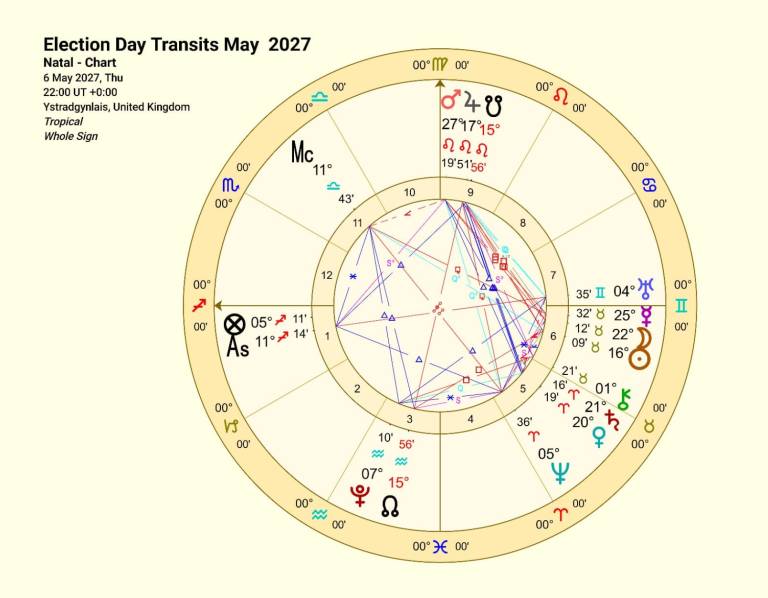How Does an Astrologer Analyse a Major Event? A Look at an Election Day Chart
One of the most common questions we receive is whether astrology can be used to understand public events, like a political election. The answer is a resounding yes, but the *way* we do it is far more nuanced than a simple "who will win?" prediction. It's a deep, psychological dive into the candidate's personal journey and the collective story of the public.
To do this properly, an astrologer needs to synthesise two different "maps."
- The Personal Map: The candidate's natal chart, which is their personal, psychological blueprint.
- The World's Map: An "event chart" cast for the specific time and place of the election, which shows the public mood and the archetypal forces at play.
A full, personal analysis of a specific candidate (like Martyn) isn't possible in a public blog post, as it requires a private natal chart. However, we *can* use this event chart, for an election on May 6, 2027, as a case study. This allows us to demonstrate the exact method an astrologer uses to read the "story" of the event itself.

Part 1: The Personal Story (The Method)
If we were analysing a candidate's re-election bid, our first step would be to look at their natal chart. This map, unique to them, shows their innate strengths, challenges, and psychological patterns. It's the "inner world" of the candidate.
We would then overlay the "event chart" (the planets' positions on election day) on top of their natal chart. This is called analysing the transits.
This process is not about "predicting fate." It's about psychological insight. We would ask:
- Is the transiting Sun (the "spotlight" of the moment) illuminating the candidate's 10th House of career and public reputation?
- Where is transiting Jupiter (the planet of expansion and luck) offering a fortunate opportunity in their personal map?
- How is transiting Saturn (the planet of responsibility and challenge) testing their resolve?
This is the core of psychological astrology. We are looking to see how the "outer" event is activating the "inner" potential and conflicts of the person. It's a map of their *personal journey* through the public ordeal.
Part 2: The Public Story (Analysing the Event Chart)
This is where Mundane and Electional astrology, which our own Martyn J. Shrewsbury has trained in, become vital. We can analyse the event chart *itself* to understand the "personality" of the election day.
Let's look at our 2027 example chart, which is cast for 10:00 PM (22:00), a common time for the close of polls.
The "Personality" of the Event: The Ascendant
The chart's Ascendant (the rising sign) is 11° Sagittarius. The Ascendant sets the tone for the event. Sagittarius is an optimistic, expansive, and future-focused sign. This tells us the election is likely to be "about" big-picture ideas, philosophies, and debates on the future. The mood is less about small details and more about the overarching vision.
The "Public Goal" of the Event: The Midheaven (MC)
The Midheaven (the 10th House cusp) is at 11° Scorpio. This is one of the most crucial points, as it represents the public outcome and reputation of the event. Scorpio is a sign of power, control, transformation, and things that are hidden. This suggests the "goal" of this election is a profound, transformative shift in power. The atmosphere surrounding the result is likely to be intense, passionate, and may involve "all or nothing" stakes or the revealing of hidden information.
The "Public Mood": The Moon
We always look to the Moon to understand the "people" or the public. In this chart, the Moon is at 21° Taurus, joined by the Sun at 16° Taurus. This is a powerful counter-balance to the fiery Sagittarius Ascendant. The public (Moon) is not focused on abstract philosophies; they are in earthy, pragmatic Taurus. This tells us the voters are concerned with tangible, "bread and butter" issues: financial security, stability, resources, and common-sense solutions. They want solid ground under their feet.
Putting the Two Stories Together
A master astrologer's job is to weave these threads. In our example, we see a fascinating tension: the "event" is framed as a big, philosophical debate (Sagittarius Ascendant), but the *public* is actually focused on material security (Taurus Moon), and the *outcome* is about a deep, transformative power shift (Scorpio MC).
A candidate's success would depend on how their *personal* chart (their transits) allows them to navigate this landscape. Can they bridge the gap between "big ideas" and "practical needs"? How are they equipped to handle the intense, power-focused nature of the outcome?
This is the true value of astrological analysis. It moves us beyond a simple "yes or no" and into a rich, symbolic understanding of the complex psychological forces that shape our world and our lives. It's this deep, archetypal dialogue, the same method Martyn applies in his work, that we are passionate about exploring at the Wilfred Hazelwood Clinic.




